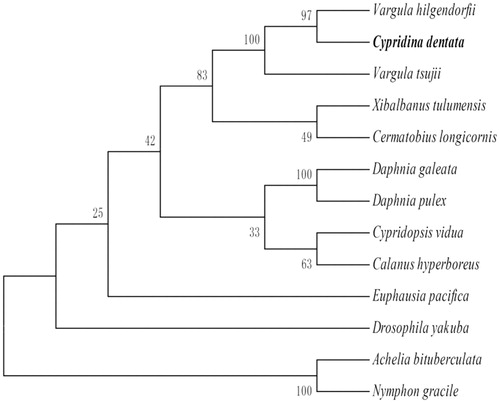Abstract
The complete mitogenome of Cypridina dentata was sequenced in the present study. The results are as follows: (1) the total length of the mitogenome is 15,779 bp; (2) the gemome contains 37 genes, consisting of 13 protein-coding genes, 22 tranfer-RNA genes, 2 ribosomal-RNA genes, and 2 noncoding regions. The most common start codon is ATG, the most common termination codon is TAA and two genes have incomplete termination codon T– –. The A + T composition is higher than C + G. The data will increase the basic information of zooplankton phylogenetic research and can help to better understand the phylogenetic status of C. dentata in phylum Arthropoda.
Cypridina dentata are mainly distributed in the coastal waters. In China, this species is abundanthly found in the western coast of Taiwan Strait (Chen Citation1982) and usually found in the adjacent areas of Changjiagn River Estuary (Chen and Xu Citation2009) and Beibu Gulf (Zhao et al. Citation2007). Similarlymost of this species are largely confined in the neritic areas and off the west coast of India (George and Nair Citation1980; Purushothaman Citation2015). Otherwise, due to the wide adaptation to temperature (Xu Citation2007), C. dentata is found in the Tsushima Current (Xu Citation2007) and could be one of the dominant zooplankton species collected in 10°S of the Bay of Bengal (Li et al. Citation2017).
We collected C. dentata samples with vertical haul at two stations (122°30.8′E, 31°30.2′N; 122°59.6′E, 31°30.6′N) offshore Changjiang River Estuary in October 2018 with WP2 net (mesh size: 200 μm) from near the sea bottom to the surface. The samples were frozen in –80 °C immediately on board until was picked out for mitogenome analysis under a dissecting microscope. Some specimen of C. dentata were preserved in formalin solutions stored in the plankton laboratory of the First Institute of Oceanography, Ministry of Natural Resources. Through this study, we get the complete mitogenome of C. dentata, which will help to better understand the phylogenetic status of this species in phylum Arthropoda.
The mitogenome of C. dentata is circular, with the overall length of 15,779 bp which had been submitted to GenBank with the accession No. MK482395. The genome contains the same 37 genes usually found in other Arthropoda species, including 13 protein-coding genes (PCGs), 22 transfer-RNA genes, and 2 ribosomal-RNA genes. Otherwise, two non-coding regions (D-loop) occurred with 700 bp and 776 bp in length, respectively. The most common inferred initiation codon of 13 PCGs is ATG, except that ND3, ND5 with ATA, GTG as the initiation codon, respectively. The most common inferred termination codon is TAA, and ND3, ND4, COX2, ATP8 with TAG as their termination codon. In addition, ND5 has an incomplete termination condon T––.
The mitochondrial base composition of C. dentata is A 33.36%, T 29.49%, C 24.53% and G 12.62% in the heavy strand, with a higher proportion of A + T composition. Similarly, the A + T composition (67.96%) of noncoding regions was higher than C + G.
This is the first record of the complete mitochondrial genome of genus Cyridina. But, in the family cypridinidae, there have been other two recorded complete mitochondrial genome, i.e. Vargula hilgendorfii and V. tsujii. The phylogenetic relationship of C. dentata with other species in phylum Arthropoda were estimated using the Maximum Likelihood method in RAxML 8.1.5. According to , C. dentata has a more close relationship with V. hilgendorfii than its congeneric species V. tsujii.
Figure 1. Phylogenetic relationship of 13 species in phylum Arthropoda based on the concatenated data set of 13 protein-coding genes. Genbank accession numbers: Vargula hilgendorfii (NC005306), V. tsujii (NC039175), Xibalbanus tulumensis (NC005938), Cermatobius longicornis (NC021403), Daphnia galeata (NC034297), D. pulex (KT003819), Cypridopsis vidua (KP063117), Calanus hyperboreus (NC019627), Euphausia pacifica (EU587005), Drosophila yakuba (NC001322), Achelia bituberculata (NC001322) and Nymphon gracile (NC008572).

Disclosure statement
No potential conflict of interest was reported by the authors.
Additional information
Funding
References
- Chen H, Xu ZL. 2009. Seasonal distribution of pelagic Ostracoda in the Changjiang Estuary and its adjacent waters. Chin J Appl Environ Biol. 15:72–77.
- Chen RX. 1982. The distribution of pelagic Ostracoda in the western coast of Taiwan Strait. Acta Oceanol Sinica. 1:289–298.
- George J, Nair VR. 1980. Planktonic Ostracods of the northern Indian Ocean. Mahasagar-Bull Natl Institu Oceanogr. 13:29–44.
- Li KZ, Yin JQ, Huang LM, Tan YH, Lin Q. 2017. A comparison of zooplankton community in the Bay of Bengal and South China Sea during April–May, 2010. J Ocean Univ China. 16:1206–1212.
- Purushothaman J. 2015. Diversity of pelagic Ostracods (Crustacea: Ostracoda) in the mix layer of northeastern Arabian Sea during the summer monsoon. J Threatened Taxa. 7:6980–6986.
- Xu ZL. 2007. Study on adaptation and ecotype of pelagic Ostracoda in the East China Sea. Acta Oceanol Sinica.29:123–131.
- Zhao HQ, Li CH, Du FY, Wang XF, Li ZD, Jia XP. 2007. Species composition, abundance distribution and diversity of planktonic Ostracoda in Beibu Gulf. Acta Ecolgocia Sinica. 27:25–33.
